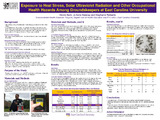Exposure to Heat Stress, Solar Ultraviolet Radiation and Other Occupational Health Hazards Among Groundskeepers at East Carolina University
Author
Beck, Nicole C.
Abstract
Groundskeepers work most of the year outdoors, performing physically demanding duties. The amount of time spent working outdoors exposes groundskeepers to various hazards including physical hazards (hot temperatures, cold temperatures, ultraviolet radiation [UVR]), various arthropods (e.g., mosquitoes, ticks), and ergonomic hazards associated with bending, kneeling, and awkward posture for prolonged periods. This study assessed exposure to heat, cold, UVR, arthropods, and ergonomic hazards among East Carolina University groundskeepers (n=44). Groundskeepers completed pre-and post-surveys to determine any changes in hazard exposures and knowledge on personal protective equipment (PPE) use. Heat stress indices and UV indices were recorded three times a day (morning, noon, afternoon) in work areas. Heat stress, UVR monitoring and arthropod collection were conducted during three seasons: summer, fall, spring. Arthropod collections were conducted in selected work areas weekly. Differences in the mean and median heat stress and UV indices within the seasons (P[less than]0.01), months (P[less than]0.01), and time of day (P[less than]0.01) were significant. In addition, differences in the mean and median UV indices by weather were also significant (P[less than]0.01). Heat stress, UVR monitoring and arthropod collection were conducted during three seasons: summer, fall, spring. Arthropod collections were conducted in selected work areas weekly. The only diurnal arthropods collected were four Aedes Albopictus mosquitoes and 864 mosquitoes of five genera and 14 species were collected. Findings of this study will be beneficial in identifying recommended controls for heat stress (e.g., scheduling heavy work during colder months and times of the day, taking frequent breaks, sufficient fluid intake) and UVR (e.g. scheduling outdoor work in the morning, personal protective equipment use) exposure.
Description
Presented for World Environmental Health Day, September 26, 2016 in Greenville, North Carolina.
Date
2016-09-26
Collections

